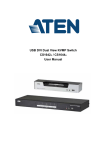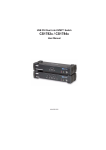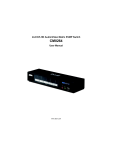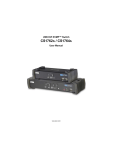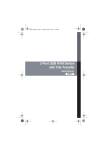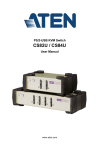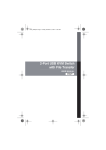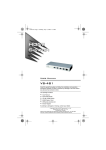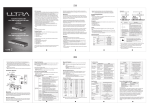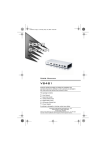Download ATEN Technology usb User's Manual
Transcript
USB 2.0 DVI KVM Switch USER MANUAL CS682 FCC Information Federal Communication Commission Interference Statement: This equipment has been tested and found to comply with the limits for a Class B digital service, pursuant to Part 15 of the FCC rules. These limits are designed to provide reasonable protection against harmful interference in a residential installation. Any changes or modifications made to this equipment may void the user’s authority to operate this equipment. This equipment generates, uses, and can radiate radio frequency energy. If not installed and used in accordance with the instructions, may cause harmful interference to radio communications. However, there is no guarantee that interference will not occur in a particular installation. If this equipment does cause harmful interference to radio or television reception, which can be determined by turning the equipment off and on, the user is encouraged to try to correct the interference by one or more of the following measures: Reorient or relocate the receiving antenna; Increase the separation between the equipment and receiver; Connect the equipment into an outlet on a circuit different from that which the receiver is connected; Consult the dealer or an experienced radio/television technician for help. FCC Caution: Any changes or modifications not expressly approved by the party responsible for compliance could void the user's authority to operate this equipment. RoHS This product is RoHS compliant. SJ/T 11364-2006 The following contains information that relates to China. CS682 User Manual Online Registration International http://eservice.aten.com Telephone Support International 886-2-8692-6959 China 86-10-5255-0110 Japan 81-3-5615-5811 Korea 82-2-467-6789 North America 1-888-999-ATEN ext 4988 United Kingdom 44-8-4481-58923 Technical Support For international online technical support – including troubleshooting, documentation, and software updates: http://eservice.aten.com For North American technical support: Email Support Online Technical Support [email protected] Troubleshooting Documentation Software Updates Telephone Support http://www.aten-usa.com/support 1-888-999-ATEN ext 4998 -3- Package Contents The CS682 USB 2.0 DVI KVM Switch package contains the following items: 1 CS682 2-Port USB 2.0 DVI KVM Switch 1 Remote Port Selector 1 User Manual* 1 Quick Start Guide Check to make sure that all the components are present and that nothing got damaged in shipping. If you encounter a problem, contact your dealer. Read this manual thoroughly and follow the installation and operation procedures carefully to prevent any damage to the unit, and/or any of the devices connected to it. * Features may have been added to the CS682 since this manual was printed. Please visit our website to download the most up-to-date version of the manual. Copyright © 2013 ATEN® International Co., Ltd. Manual Date: 2013-12-02 - Manual Part No. PAPE-1337-AT4G ATEN and the ATEN logo are trademarks of ATEN International Co., Ltd. All rights reserved. All other trademarks are the property of their respective owners. -4- Overview The CS682 takes a giant step forward from prior cable KVM models in the Petite series, by offering DVI functionality, USB 2.0 peripheral sharing (via a USB hub attached to the USB mouse port), a rich bass experience for 2.1 surround systems, and a firmware upgrade function that allows you to keep up with latest available versions. Another new feature of the CS682 is the implementation of a remote port selector. This means that you can now control port switching from the desktop while the switch itself can be placed in a convenient, out-of-the-way, location. Also, in addition to new hotkeys, the CS682 offers the latest mouse port-switching function – simply double-click on the scroll wheel of a USB mouse to change ports. Furthermore, the CS682 features enhanced Video DynaSync technology, which eliminates boot-up display problems and optimizes resolution when switching between ports. Finally, the CS682's new Power on detection feature means that if one of the computers is powered off, switch will automatically switch to the other powered-on computer. Featuring an unbeatable combination of DVI functionality, USB 2.0 peripheral sharing convenience, and enhanced user-friendly operations, the CS682 allows users to keep up with the latest innovations in desktop multimedia applications. -5- Features One DVI video console controls two USB computers Fully DVI-Digital specification compliant Computer selection via remote port selector, hotkeys, and USB mouse Audio-enabled – full bass response provides a rich experience for 2.1 channel surround sound systems Multiplatform support – Windows 2000 / XP / Vista / 7, Mac, Sun, Linux Compact design, built-in all-in-one cables (2 x 1.2 m) Superior video quality – up to 1920 x 1200 Compatible with widescreen LCD monitors Video DynaSync – exclusive ATEN technology which eliminates boot-up display problems and optimizes resolution when switching between ports Power on detection – if either of the computers is powered off, the CS682 will automatically switch to the other computer Supports multimedia keyboards Supports wireless keyboards and mice Console mouse port emulation/bypass feature supports most mouse drivers and multifunction mice Mac/Sun keyboard support and emulation* USB 2.0 mouse port can be used for USB hub and USB peripheral sharing HDCP Compliant Non-Powered Firmware upgradable Note: 1. PC keyboard combinations emulate Mac/Sun keyboards. 2. Mac/Sun keyboards work only with their own computers. -6- 3. To use the USB 2.0 mouse port as a USB hub, you must first disable mouse emulation mode. See Hotkey Summary Table, page 15 for information. System Requirements Console A DVI monitor capable of the highest resolution that you will be using on any computer in the installation A USB Keyboard and a USB Mouse Speakers and microphone (optional) Computers The following equipment must be installed on each computer that is to be connected to the system: A DVI video port USB Type A port Speaker and microphone ports (optional) Cables The CS682’s innovative design features built-in KVM and audio cables for extra convenience. No further cables are necessary. -7- Operating Systems Supported operating systems are shown in the table, below: OS Windows Linux Version 2000 / XP / Vista / 7 RedHat 6.0 and higher SuSE 8.2 and higher Mandriva (Mandrake) 9.0 and higher UNIX Novell AIX 4.3 and higher FreeBSD 3.51 and higher Sun Solaris 9 and higher Netware 5.0 and higher Mac OS 9 and higher DOS 6.2 and higher -8- Components CS682 1 2 3 3 5 4 6 7 Remote Port Selector 3 8 -9- No. Component Description 1 Console Audio Ports Your console speakers and microphone plug in here. 2 Console Monitor Port Your console DVI monitor plugs in here. 3 Port LEDs The Port LEDs indicate status. The LED lights on to indicate that the computer attached to the corresponding port is selected and has the KVM focus. The LED flashes to indicate that the computer attached to its corresponding port is being scanned by the Auto Scan function. The LED is off to indicate the port is not selected. 4 KVM Cable The connectors on the built-in KVM cables attach to the two computers in your CS682 installation. See the diagram on page 12 for further details. 5 Console Keyboard Port Your console USB keyboard plugs in here. 6 Console Mouse Port Your console USB mouse plugs in here. 7 Remote Port Selector Jack The Remote Port Selector plugs in here. 8 Port Selection Pushbutton Press the Port Selection Pushbutton to toggle the KVM and Audio focus between the two computers. - 10 - Installation 1. Make sure that the power to any device that you connect to the installation has been turned off. You must unplug the power cords of any computers that have the Keyboard Power On function. 2. Make sure that all devices you will be installing are properly grounded. 1. Plug your keyboard and mouse into their USB ports, located on the side of the CS682. The ports are color coded and labeled with an appropriate icon. Note: The mouse connector is actually a USB 2.0 port, and can accept any USB compatible peripheral. You can even connect a hub to install multiple USB devices (This may require an extra power adapter). 2. Plug your monitor into the DVI port, located on the front of the CS682. Power on the monitor. 3. Plug your speakers and microphone into the console audio ports, located on the front of the CS682 (Optional). 4. Plug the USB, video, and audio connectors of the KVM cables into their respective ports on the computers you are installing. 5. If you choose to use the remote port selector, plug its cable into the remote port selector jack, located on the side of the unit. 6. Power on the computers. Note: By default the switch links to the first computer that is powered on. - 11 - Installation Diagram 3 4 1 5 or USB 2.0 Hub 4 KVM Cable - 12 - 2 Operation The CS682 provides three convenient methods of selecting computers: Manual – click the pushbutton on the Remote Port Selector; Mouse – click the mouse’s scroll wheel; and Hotkey – enter combinations from the keyboard. Manual Port Selection Press the port selection pushbutton on the Remote Port Selector to toggle the KVM and Audio focus between the two computers. The Port LED lights to indicate that the computer attached to its corresponding port has the focus. Note: Do not switch ports while a USB device is in operation. For independent USB switching, please see the USB KVMP switches on our website. Mouse Port Selection Simply double-click the scroll wheel on your USB mouse to switch between ports. The mouse port-switching function allows you to toggle back and forth between the ports. Note: 1. This feature is only supported by USB 3-key scroll wheel mice. 2. The default setting is OFF. 3. This feature is only supported when mouse emulation is also enabled. See Hotkey Summary Table, page 15 for further details. - 13 - Hotkey Port Selection All hotkey operations begin by tapping the Scroll Lock key twice. See the Hotkey Summary Table for full details. Note: If using [Scroll Lock] conflicts with other programs, [Ctrl] can be used instead. Alternate Entering Hotkey Mode Press [Scroll Lock] [Scroll Lock] [x] [Enter]. The entering hotkey mode hotkey is now [Ctrl]. or Press and hold the remote port selector switch for three seconds. The entering hotkey mode hotkey is now [Ctrl]. Note: These procedures toggle between the two methods. - 14 - Hotkey Summary Table Combination [Scroll Lock] [Scroll Lock] + Function [Enter] Toggles the KVM and Audio focus between the two ports. If the KVM and Audio focus are on different ports, only the KVM focus switches. [k] [Enter] Only toggles the KVM focus. [s] [Enter] Only toggles the Audio focus. [a] [Enter] [n] Starts Auto Scan. The KVM focus cycles from port to port at n second intervals. Note: Replace n with a number between 1 and 4 (see Scan Interval Table below). To exit Auto Scan, press [Esc] or [Spacebar]. Auto Scanning stops when you exit Auto Scan mode. [x] [Enter] Toggles the hotkey invocation key between [Scroll Lock] and [Ctrl]. [m] [Enter] Enables/disables mouse emulation function. [w] [Enter] Enables/disables mouse port-switching function. [F2] [Enter] Activates Mac keyboard mapping. [F3] [Enter] Activates Sun keyboard mapping. [F10] [Enter] Auto detects keyboard operating platform. [F4] [Enter] Lists current switch settings. [F5] [Enter] Performs a USB keyboard and mouse reset. [d] [Enter] Invokes the Video DynaSync function, which eliminates boot-up display problems and optimizes resolution when switching between ports. [e] [Enter] Enables/Disables the Power on Detection feature. [r] [Enter] Resets hotkeys to the default setting. Scan Interval Table n Secs. 1 3 secs. 2 5 secs. (default) 3 10 secs. 4 20 secs. - 15 - Keyboard Emulation PC Keyboard Mac Keyboard PC Keyboard Sun Keyboard [Shift] Shift [Ctrl] [T] Stop [Ctrl] Ctrl [Ctrl] [F2] Again [Ctrl] [F3] Props [Ctrl] [1] [Ctrl] [F4] Undo [Ctrl] [2] [Ctrl] [F5] Front [Ctrl] [3] [Ctrl] [F6] Copy [Ctrl] [4] [Ctrl] [F7] Open [Alt] Alt [Ctrl] [F8] Paste [Print Screen] F13 [Ctrl] [F9] Find [Scroll Lock] F14 [Ctrl] [F10] Cut = [Ctrl] [1] [Enter] Return [Ctrl] [2] - [Backspace] Delete [Ctrl] [3] + [Insert] Help [Ctrl] [4] F15 [Ctrl] [H] [Ctrl] Help Compose Note: When using key combinations, press and release the first key (Ctrl), then press and release the activation key. - 16 - The Firmware Upgrade Utility To upgrade the CS682’s firmware, do the following: 1. From a computer that is not part of your KVM installation, download the latest Firmware Upgrade package for the CS682 from our Internet support site (www.aten.com). 2. Disconnect the CS682 from your KVM installation. Press and hold the Remote Port Selector’s pushbutton. While you are still holding the pushbutton, connect the KVM cable’s purple USB connector to a USB port on the computer you have downloaded the Firmware Upgrade package to. 3. The CS682 now enters Firmware Upgrade Mode. The two Ports LEDs flash together to indicate that the unit is in Firmware Upgrade Mode. Note: While the CS682 is in Firmware Upgrade Mode, normal keyboard and mouse functions are suspended. You must complete the firmware upgrade or exit Firmware Upgrade Mode to regain normal control of the console. 4. Run the Firmware Upgrade Package file. The Firmware Upgrade Utility Welcome screen appears. 5. Read the License Agreement and enable to I Agree button. 6. Click Next to continue. The Firmware Upgrade Utility main screen appears. All the devices capable of being upgraded by the package are listed in the Devices List panel. 7. Select your device. Its description appears in the Device Description panel. Click Next to perform the upgrade. As the upgrade proceeds, status messages appear in the Status Messages panel, and the progress towards completion is shown in the Progress bar. 8. After the upgrade has completed, a screen appears to inform you that procedure was successful. Click Finish to close the Firmware Upgrade Utility. 9. Set up your KVM installation again. See Installation, page 11. - 17 - Upgrade Failed If the Upgrade Succeeded screen doesn’t appear, it means that the upgrade failed to complete successfully, in which case you should do the following: 1. Disconnect the USB connectors on the KVM cables from the computer. 2. Press and hold the Remote Port Selector’s pushbutton. While you are still holding the pushbutton, reconnect the KVM cable’s USB connectors to the computer. 3. Power on the CS682. It will now work with the factory default firmware. Follow steps 3 to 9 on page 17 again. Troubleshooting Symptom Possible Cause Action Monitor does not display after the KVM cable set is hot-plugged. DVI graphics card is not compatible with cable set hotplugging. Power off all devices on the installation; power off the CS682; confirm all KVM cables are properly connected; power on the CS682; power on the computers. Graphics card Upgrade to the latest graphics driver is not up-to- card driver. date. Mouse and/or keyboard is not responding. Switch needs to be reset. Power off all devices on the installation; power off the CS682; wait five seconds; power on the CS682 again. Mouse portMouse does not switching support this function is not function. responding. Mouse emulation is disabled. This feature is only supported by USB 3-key scroll wheel mice. Cannot switch ports by pressing [Scroll Lock] twice. Switch to the alternate HSM invocation keys. See Alternate Entering Hotkey Mode, page 14, for details. Keyboard is incompatible with [Scroll Lock] invocation. Enable mouse emulation. See Hotkey Summary Table, page 15, for details. - 18 - Specifications Function CS682 Computer Connections 2 Console Connections 1 Port Selection Connectors Remote Port Selector, Mouse, Hotkeys Console Ports KB 1 x USB Type A Female (Silver) Video 1 x DVI-D Female (White) Mouse 1 x USB Type A Female (Silver) Speakers 1 x Mini Stereo Jack Female (Green) Mic. 1 x Mini Stereo Jack Female (Pink) KB 2 x USB Type A Male (Purple) Video 2 x DVI-D Male (Black) KVM Ports Mouse 2 x USB Type A Male (Black) Speakers 2 x Mini Stereo Jack Female (Green) Mic. 2 x Mini Stereo Jack Female (Pink) Remote Port Selector LEDs Cable Length 1 x Mini Stereo Jack KVM 2 (Green) Remote Port Selector 2 (Green) KVM 2 x 1.2 m Remote Port Selector Emulation 1. 8 m KB / Mouse USB Video 1920 x 1200 Scan Interval 3, 5, 10, 20 secs. (default 5 secs.) Power Consumption Environment 5V, 3.05W Operating Temp. 0–50ºC Storage Temp. Physical Properties -20–60ºC Humidity 0–80% RH, Non-condensing Housing Plastic Weight 0.50 kg Dimensions (L x W x H) 11.10 x 7.80 x 2.50 cm - 19 - Factory Default Hotkey Settings Setting Default Port Switching [Scroll Lock] [Scroll Lock] Auto Scan Interval 5 seconds Keyboard Operating Platform PC Compatible Mouse Emulation On Mouse Port-Switching Off Power on Detection Enabled Limited Warranty IN NO EVENT SHALL THE DIRECT VENDOR'S LIABILITY EXCEED THE PRICE PAID FOR THE PRODUCT FROM THE DIRECT, INDIRECT, SPECIAL, INCIDENTAL OR CONSEQUENTIAL DAMAGES RESULTING FROM THE USE OF THE PRODUCT, DISK OR ITS DOCUMENTATION. The direct vendor makes no warranty or representation, expressed, implied, or statutory with respect to the contents or use of this documentation, and specially disclaims its quality, performance, merchantability, or fitness for any particular purpose. The direct vendor also reserves the right to revise or update the device or documentation without obligation to notify any individual or entity of such revisions, or update. For further inquires please contact your direct vendor. - 20 -






















